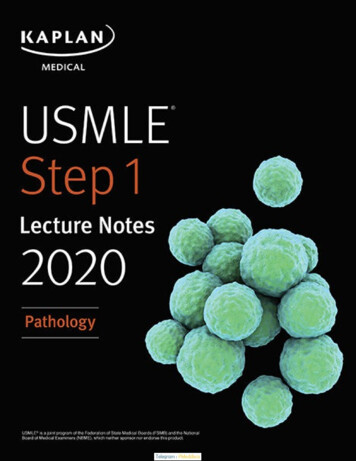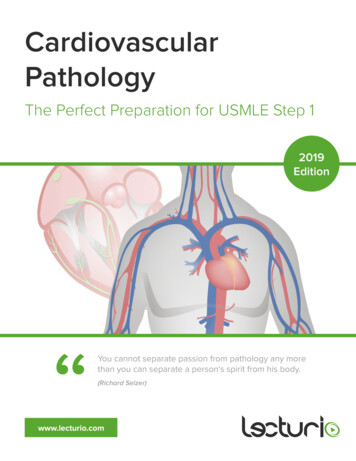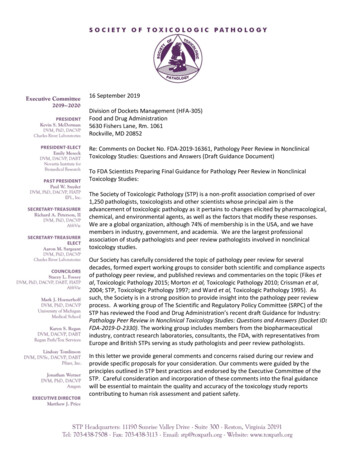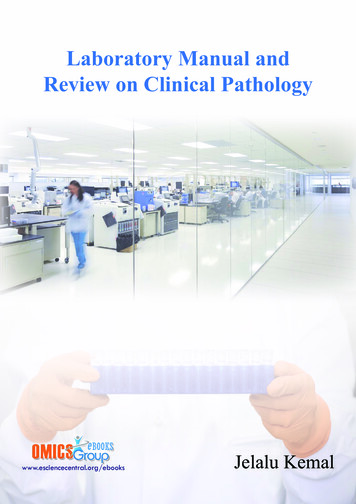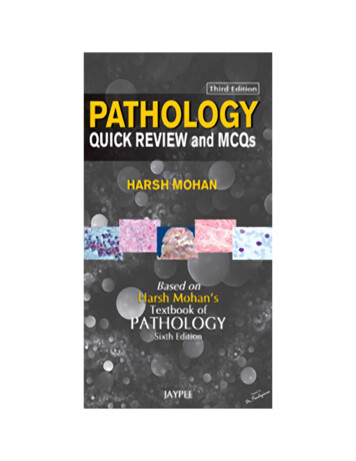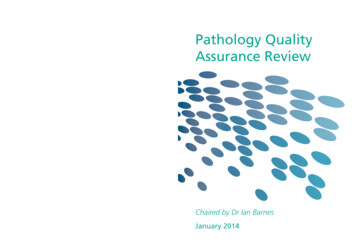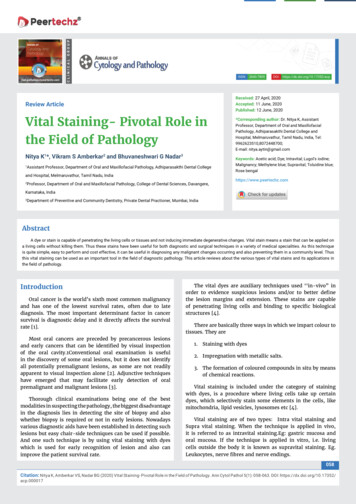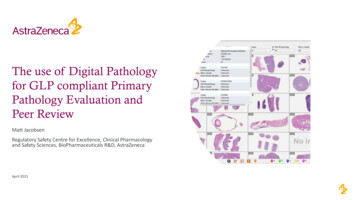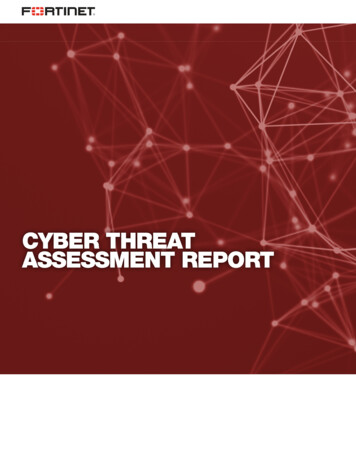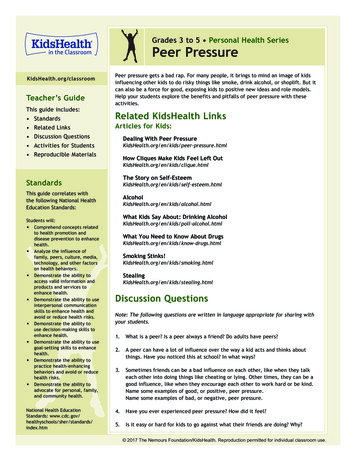
Transcription
1500 K Street, NWSuite 1100Washington, DC 20005Telephone: 1 202.230.5621Email: info@iqconsortium.orgWebsite: https://iqconsortium.orgIQ CONSORTIUM COMMENTS ON FDA-2019-D-2330PATHOLOGY PEER REVIEW IN NONCLINICAL TOXICOLOGY STUDIES:QUESTIONS AND ANSWERS; GUIDANCE FOR INDUSTRY; DRAFT GUIDANCEWe are pleased to offer the following comments, developed by the DruSafe Leadership Group(with input from the Quality Leadership Group) of the International Consortium for Innovationand Quality in Pharmaceutical Development (www.iqconsortium.org). The IQ Consortium is anot-for-profit organization of pharmaceutical and biotechnology companies with a mission ofadvancing science and technology to augment the capability of member companies to developtransformational solutions that benefit patients, regulators and the broader research anddevelopment community.The IQ Consortium and DruSafe Leadership Group appreciate the opportunity to review thedraft guidance and to share detailed feedback below. First, general comments on the currentdraft guidance’s text are presented. In the table that follows, specific comments and proposedrevisions are provided for your consideration.The IQ Consortium hopes this feedback will assist the Agency in their efforts. If you requireclarification of any of these comments, please contact Dr. Ann Marie Stanley at the IQConsortium Secretariat:IQ Consortium Secretariat*1500 K Street NWWashington DC 20005Telephone: (202) 230-5158Fax: (202) 842-8465Web: www.iqconsortium.orgEmail: annmarie.stanley@dbr.com*Secretariat, Drinker Biddle & Reath LLPGENERAL COMMENTS ON PATHOLOGY PEER REVIEW IN NONCLINICALTOXICOLOGY STUDIES: QUESTIONS AND ANSWERS DRAFT GUIDANCEFOR INDUSTRYThe goal of the pathology peer review is to assist the study pathologist with the creation of thebest, most accurate set of histopathology data and interpretations of those data to describe thetoxicity of the test article in the test system under the conditions of the nonclinical study. Somedetails outlined in the draft guidance, particularly as they pertain to how the process of peer reviewis recorded, appear to jeopardize the main goal and collaborative benefit of performing a peer
review. There is fundamental disagreement on what should be included in the peer reviewstatement (A5) and how differences in interpretation between the pathologist and the peer reviewpathologist should be recorded (A9). The area of greatest concern is the lack of trust in the integrityof pathologists to perform their job role (Q8). The remainder of the discussion and detailedcomments in the table are recommendations intended to increase the clarity in the guidance anddrive consistency throughout the industry.DruSafe agrees with the FDA position that “Casual discussions, consultations, opinion exchange,and mentoring among pathologists do not constitute formal pathology peer review and are notcovered by this guidance document.” However, each organization’s interpretation of these aspectsof communication versus what constitutes a formal peer review are expected to result in substantialdifferences in detailed documentation. In addition, the iterative process of communication betweenthe primary pathologist and peer review pathologist would be made cumbersome if documentationand justification are required along the way. The current philosophy of the industry is that theretention of interim information, working notes, communications to reconcile differences ofopinions or draft versions of narrative reports from prospective/contemporaneous peer reviews isnot essential for the reconstruction and understanding of the pathology section of the final studyreport, and do not require an audit trail or retention after the pathology report is finalized (Mortonet al, 2010; US FDA 1987).The expectation of an audit trail initiation in between the study pathologist and peer reviewpathologist analysis appears to change the definition of pathology raw data. In addition, theinitiation of an audit trail on interim data poses a burden to both study conduct and qualityassurance units to manage this information for data which is not considered final, as identified inthe 1987 GLP Final Rule1. It is strongly recommended that the expectation of an audit trailinitiation prior to the peer review pathologist analysis be removed from the draft guidance prior tofinalization.Regarding ‘undue influence’, it is not in any Sponsor’s best interest of patient safety tomischaracterize a nonclinical hazard. The essential correspondence to retain as part of peer reviewactivities are communications that reflect the process, plans and expectations directly linked to theslides used in peer review (Fikes et al, 2015). Examples include correspondence on the processinvolved in the selection of slides for review, the selection of animals for full slide review, and theselection of potential target tissues for review in remaining animals. However, communicationsregarding preliminary pathology observations prior to final database lock and the generation ofhistopathology raw data by the study pathologist’s signature of the narrative report are not neededfor reconstruction of the histopathology portion of the study and would not be required to bemaintained, in accordance with FDA, OECD and Japanese Ministry of Health Labour and Welfareguidance (US FDA 1987, OECD guidance no. 16, 2014, and Japanese MHW 1997). In addition tothe ability to reconstruct the pathology section of the study, additional safeguards are the retentionof specimens, allowing a third party or FDA to evaluate the slides themselves, in the rare eventthat a concern arises for unethical practice.Finally, DruSafe has the consensus opinion that FDA and OECD need to be harmonized inpractices that drive a quality product but are also straightforward and easy to be consistent acrossthe industry. Avoiding unnecessary regulations that are prone to variability in execution will notPage 2 of 20
drive alignment and will likely result in confusion and misinterpretation which could delay ourmain goal of getting new medicines to patients. We would like to take this opportunity to thankFDA for considering DruSafe’s opinion and input on this draft guidance.SPECIFIC COMMENTS ON PATHOLOGY PEER REVIEW IN NONCLINICALTOXICOLOGY STUDIES: QUESTIONS AND ANSWERS DRAFT GUIDANCEFOR INDUSTRYLines- Guidance textFDAGeneral The intent of comment isto provide an overarchingstatement thatacknowledges that whilesome of the principlesarticulated in the draftreflect best practices intoxicologic pathology,there are major points ofconcern regardingQuestions 5 and 8 relatedto the degree ofdocumentation ofdifferences forprospective peer reviewwhich appears to conflictwith the definition ofpathology raw data asstipulated in the topathologicalassessment (lines 34/35)Findings (53)Interpretations (55)Output (57)CommentAs the introduction of the draft guidance notes,documentation of practices during peer review have not beenclearly defined and vary among testing facilities. While it istrue that these practices have not been codified in regulatoryguidance, it is important to note that the toxicologicpathology community has carefully considered bothscientific and compliance aspects of pathology review andpublished documents related to pathology peer review (Fikeset al, Toxicologic Pathology 2015; Morton et al, ToxicologicPathology 2010; STP, Toxicologic Pathology 1997; andWard et al, Toxicologic Pathology 1995). These documentswere prepared by expert panels of pathologists and IQDruSafe suggests that the principles in these publicationsprovide a strong scientific basis for both the scientificconduct of a peer review as well as appropriatedocumentation practices to allow study reconstruction.The current draft guidance references several of thesepublications and we appreciate that in many of the questions(Q1-4, and 6-7) portions of these practices have beenadopted. Our primary concern regards statements in Q 5and 7 related to the nature of documentation required inprospective peer review of any differences between theprimary and peer review pathologist. While we appreciatethe agency’s desire to be assured that primary pathologistsare not unduly influenced during the peer review process, thereport practices suggested for prospective peer review in thisdraft guidance will not guarantee undue influence, will add anotable and cumbersome addition to the reporting process,and will likely result in pathology narratives which may beunclear and confusing to non-pathologists. More detailedcomments are described below.Terminology around the conduct of the histopathology phaseof a toxicology study and pathology peer review usedthroughout this document (e.g. histopathological assessment,findings, interpretations, and output) is confusing. It wouldbe helpful to more clearly define these terms in thePage 3 of 20
Line 36(Background)Lines37-39Lines43-44Line 53(A1)Line 55Lines56-57Lines57-58Lines60-61introduction and use them consistently throughout thedocument. .includes an initial read Recommend changing colloquial term “read” to “evaluate”of tissue slides by theto take into account the pathologist’s training, experiencestudy pathologist .and understanding of the range of normal tissuemorphologies, background observations andpathophysiology.Pathology peer review can The scope of pathology peer review is broader thanbe particularly useful indescribed here; it is not just for unique or unexpectedsituations where unique or findings and is intended as a quality control measure tounexpected findings areensure accuracy of diagnoses, consistency of terminology,noted or when the peerand appropriate interpretation of pathology findings.review pathologist has aparticular expertise with aclass of compounds.Pathology peer review can The expectation of initiating an audit trail on interimbe valuable whenmicroscopic data in between the study pathologist and peerperformed during thereview pathologist reviews adds a level of complexity andconduct of a GLP study, confusion to the dataset without added benefit. Given thatpathology peer review is the signed and dated pathology report is considerednot specifically addressed pathology raw data, the added burden to administer a processin GLP regulations.which is not a regulatory requirement may prompt someentities to discontinue the peer review process. This wouldweaken the GLP quality management system.Pathology peer review is It is unclear here what ”the findings” means and if thethe process by which the expectation is that a peer review pathologist reviews both thefindings of the pathologist recorded morphologic diagnoses and the interpretation ofthese within the context of the study. Recommend clarifyingin this section. .or group ofAdd pathology working group as follows:pathologists (peer-review“ or group of pathologists (peer review pathologists or apathologists).pathology working group, PWG).”Interpretations ofhistopathological changesare made using expertscientific and medicaljudgment resulting inoutput that is mostlyqualitative and thereforesubjectivePathology peer review canhelp to ensure the qualityand accuracy ofhistopathologicaldiagnoses andinterpretationsCasual discussions,consultations, opinionexchange, and mentoringRecommend deleting “and therefore subjective”Consistency should be mentioned as well, as this is a keyelement of the pathologist’s work.Clarify and/or define what is meant by a “formal pathologypeer review” as compared to “casual discussions,consultations, opinion exchange and mentoring” and whoPage 4 of 20
among pathologists do notconstitute formalpathology peer review andare not covered by thisguidance s78-79(A3)Lines80-81may or may not be included in the definitions of pathologistsin these roles.Suggest replacing “casual” with “informal” and delete“opinion exchange”. The types of interactions describedhere are critical components of the iterative process ofarriving at a diagnosis in both the experimental anddiagnostic pathology arenas. We fully support that boththese interactions, as well as the exchange of informationbetween the primary and peer review pathologist that occursas part of study preparation are not necessary for studyreconstruction and are out of scope of the guidance.The peer-review“Sufficient knowledge” may be more appropriatepathologist should have a terminology than “experience” in the first sentence.combination ofappropriate education,training, and experienceto be qualified to renderopinions on the studypathologist’s histologicaldescriptions.In addition, the peerAppropriate experience to perform the peer review does notreview pathologist should always require specific expertise in all of these aspects.have experience with theroute of administration ofthe test article, speciesand strains of animalsbeing tested, and durationand design of the studyFurthermore, it can alsoChange the word “can” to “is” – “Furthermore it is alsobe beneficial for the peer- beneficial .”review pathologist to haveknowledge of themechanism of action ofthe test article andknowledge of the resultsof test articleadministration at otherdose levels or in otherspecies.Pathology peer review“Prospective” corresponds to “contemporaneous” I OECDthat occurs beforeGuideline. Recommend harmonization.finalization of the studypathologist’s report isconsidered prospectivepeer reviewpathologist shouldRecommend changing “prepare a draft pathology report” tocomplete the analysis of“prepare study pathologist interpretation.”all slides and prepare adraft pathology reportPage 5 of 20
before the prospectivepeer review occurs.We concur that it is optimal for the draft pathology report tobe prepared prior to the initiation of the prospectivepathology peer review; however, as written, the text is notsufficiently flexible to accommodate many study designsand reporting processes. Specifically, in order toaccommodate pathologist scheduling and efficientevaluation and reporting it is necessary for both the primaryand peer review process to be divided into multiple phases.For example, certain tissues or special techniques may havesignificantly longer processing times and it may be mostefficient to have all “routine” tissues processed, evaluated,and peer reviewed and then the additional tissues evaluatedwhen they are available. In addition, for 2-yearcarcinogenicity studies it is most efficient for the studypathologist to begin reviewing early sacrifice animals priorto the end of the live phase. In these cases, flexibility shouldbe allowed to provide for a phase of peer review coveringthe early sacrifice animals. In all of these instances, neitherthe primary or peer review evaluation would be completeuntil all protocol-specified tissues have been reviewed andthe various phases of peer review would be documented inthe peer review statement.Recommendation: We suggest removing the languagesuggested all tissues must be evaluated prior to the start ofthe peer review and retain the language that the draftpathology interpretation should be available prior to peerreview as follows:“When pathology peer review occurs prospectively, thestudy pathologist should complete the analysis of all slidesand prepare a draft pathology interpretation before theprospective peer review occurs. In those cases where theprimary or peer review occurs in multiple phases, the draftpathology interpretation which covers the relevantphase/tissues should generally be available during the peerreview”Lines83-86Pathology peer reviewthat occurs afterfinalization of thepathology report isconsidered retrospectivepeer review. WhenWhile this practice is generally agreed to, there are cases (eg,peer review conducted in several phases and/or early deathsoccur that require early evaluation and peer review tosupport changes to the study protocol) when the full draftinterpretation cannot be available at the start of the peerreview. Recommend including flexibility to take thesepossibilities into consideration.Please clarify if retrospective peer review could be appliedfor the peer review conducted many years after fixationwithout original study pathologist, as described in OECDguidance No. 16. Please clarify if an independent report forpeer review that occurred after finalization of final report isacceptable.Page 6 of 20
pathology peer reviewoccurs retrospectively, thestudy pathologist shoulddocument any changes tothe conclusions of thestudy that result from theretrospective peer-reviewprocess in an amendmentto the final pathologyreport.Lines88-89(Q4)Lines91-93(A4)Can pathology peerreview be conducted at anon-GLP‐compliant sitefor a GLP compliantstudy?It is possible to conduct apathology peer reviewoutside of a GLPcompliant site for a GLPcompliant study providedcertain safeguards are inplace to protect theintegrity of study data.Because question 3 is focused on timing and notdocumentation we suggest the following revisions.Pathology peer review that occurs after finalization of thepathology report is considered retrospective peer review.When pathology peer review occurs retrospectively, thestudy pathologist should document any changes to theconclusions of the study that result from the retrospectivepeer-review process in an amendment to the final pathologyreport. Refer to question 5 regarding differences indocumentation practices for prospective and retrospectivepeer review.Consider alignment with OECD 16 and 20.Recommend inclusion of chain of custody documentation(condition at arrival, confirmation of arrival to study directoretc.). Secure retention of the GLP slides at a non-GLP site isto be ensured.Clarify archiving recommendation for peer reviewerdocumentationRemove the word “data” in this section: “ .to protect theintegrity of the study.”Lines93-95Lines95-96It is preferable that thepeer-review pathologistperform the review at theGLP-compliant testingfacility after receiving theappropriate training onGLP principles andrelevant internal standardoperating procedures however, if the peerreview is conducted at anon-GLP-compliant site,that fact should berecorded and justifiedwithin the study protocoland final study reportRecommend replacing the term “safeguards” with“appropriate procedures and documentation”Clarification requested: if the peer reviewer has receivedadequate training on GLP and internal SOP, we consider thathe/she is operating under the umbrella of the test facility andis GLP-compliant.Recommend removing the word ‘justified” as it impliesrequirements exist for choosing a non-GLP compliant sitefor peer review.Please clarify that the justification referred to is ensuringappropriate GLP training and documentation practices of thepeer review pathologist.Suggest deleting the sentence specifying the documentationpractices as this is covered in Q5 and this may createconfusion. We suggest the following revision:Page 7 of 20
Lines93-97Lines98-100“Regardless of where the peer review is conducted, thename, affiliation, and location (i.e., address) of the peerreview pathologist study director should follow thedocumentation practices described in Q5 of thisguidance”It is preferable that theIn an environment where global systems enable successfulpeer-review pathologistdeployment of GLP compliant business, a GLP peer reviewperform the review at the can easily be supported by global GLP training and SOPGLP-compliant testingsystems, but the site as a whole not conduct other GLPfacility after receiving the activities. Recommend this section be revised as follows:appropriate training onIt is preferable that the peer-review pathologist perform theGLP principles andreview at a GLP-compliant testing facility after receiving therelevant internal standard appropriate training on GLP principles and relevantoperating proceduresinternal standard operating procedures (SOPs); however, if(SOPs); however, if thethe peer review is conducted remotely to a GLP- compliantpeer review is conducted site, appropriate measures and documentation must beat a non-GLP- compliant undertaken to ensure that the peer review was GLPsite, that fact should becompliant. If the peer review was conducted non-GLP, thatrecorded and justifiedfact should be recorded within the study protocol and finalwithin the study protocol study report.and final study report.We contend that if the peer reviewer is GLP trained and thepathologist is conducting the peer review in a GLP standardmanner, the GLP accreditation of the facility where it isdone is not critical.Also, the name,qualifications (includingGLP training), affiliations,and address of the peerreview pathologist shouldbe documented in thestudy fileLinesThe portions of the study102-104 that were not conductedunder GLP complianceshould be explicitly statedin a study director-signedGLP compliancestatement and included inthe final study report.LinesThe process should be111-112 guided by written(A5)procedures to establish theextent of the review andensure the integrity of thestudy data.As an alternative option a centralized process (not studyrelated documentation) at the test facility could beconsidered (if defined within a respective SOP)For privacy reasons, it may be more appropriate to list onlythe city name or to use the affiliated business address for thepeer review pathologist. Home addresses can be kept in testfacility records.Clarify if this exception would include any pathology peerreviews conducted in a GLP-compliant manner at a nonGLP compliant site.Since no data is produced during a pathology peer review,and all data is safely protected within the data capturesystem under the control of the study pathologist, how couldstudy data integrity be affected by peer review, unless FDAare redefining the definition of histopathology raw data.Suggest removing the word data: “ .to ensure the integrityof the study.”Page 8 of 20
LinesA formal pathology peer116-119 review should be planned,conducted, documented,and reported inaccordance withestablished procedures.These procedures shouldbe documented andavailable to the peerreview pathologist beforeinitiation of the peerreview and should beclearly described in thestudy protocol or studyprotocol amendments andin SOPs pertaining to theGLP studies.Lines“An SOP and GLP study118-120 protocol (or protocolandamendments) should126-129 include a description ofthe peer-reviewprocedure, includingselected target tissues, thedose groups to beexamined, the number ofspecimens to be examinedin each group, andwhether the peer reviewshould be conducted in ablinded fashion. RelevantSOPs can be referencedwhere appropriate.”Peer review procedures are typically described in SOPs.The peer review statement can be used to document thedetailed activities of the peer review and to state the overallresults (i.e., that consensus was reached).Potential or suspected target tissue selection can occur at thetime of prospective peer review and having to provide aprotocol amendment with such detail will result in delays tothe completion of the process, or a study deviation ratherthan an amendment if the peer review is time-critical. It isconsidered more appropriate to include the target tissues andother details of what was evaluated (specimens, animals,etc.) in the peer review statement rather than requiring themto be decided a priori within the protocol or having toprovide a protocol amendment/deviation.In GLP studies, details from SOPs are not also repeated inStudy Protocols; this is a long established GLP practice andthis guidance, as written would inappropriately replicate thepurpose of an SOP. Since formal Peer Review detailsincluding target organs, which dose groups, the number ofspecimens examined, and blinding aspects cannot beaccurately determined until primary pathology read iscomplete, they cannot be included in the protocol. Whilethe SOP describes the standard expectations, it is not able toprovide the specific Peer Review details. The SOP doesoutline which doses, groups and animals should be reviewed,but allows the pathologist to use scientific judgement in theevaluation. Adding the information from the SOP to theprotocol is repetitive and more specific target organ detail isnot known at the time of protocol generation. The scope ofthe peer review often includes additional material notforeseen ahead of time. As written, this will requiregenerating abundant protocol amendments which are not theappropriate means of documenting prior events. The detailedinformation is included in the peer review memo, whereinformation is better explained in context of the study.Blinding is also specifically mentioned in the draft guidancePage 9 of 20
as requiring prior documentation in the SOP, Protocol orProtocol Amendments. Blinding is not routinely doneduring peer reviews. Toxicologic pathology is not conductedblindly in practice in GLP toxicity studies except in rarecircumstances, as described in multiple publications (Rouseet al., 2015; Neef et al., 2012; Holland et al., 2011).Blind examination is usually triggered by perceived subtledifferences between control and treated animals; it is anunbiased way to confirm that a suspected target organ isindeed a target organ.Therefore, the recommendation would be to reword thesentence, and state: "slide review during the peer reviewprocess may include blind examinations”Change “number of specimens to be examined in eachgroup” to “the number of animals and/or tissues examined”.Counting and documenting how many slides/specimenswere evaluated is not value-added. It is more meaningful todocument which animals and tissues were evaluated.LinesThe peer-reviewThis seems duplicitous and should not be required within the121-123 pathologist shouldstudy report since documentation of data verification and(A5)generate a signed andreview processes are not typically included in study reports.dated peer-reviewHowever, it should be retained in the study file for astatement (document,reviewer. The study report should confirm that a peer reviewreport, memorandum, or was conducted and that there was alignment betweencertificate) for inclusionpathologists. GLP study documents maintained in the studyLinesin the permanent studyfile with similar or greater impact include Note to File,177-178 files and the study report. Protocol Deviations, SOP Deviations, and raw data. The(A7)value of publishing the peer review statement within the the signed peer-review report is not evident in comparison to these other documents.statement should beOf note, the need to include the peer review statement in theincluded as an appendixfinal study report is not required in OECD guideline.to the final study reportand should also beincluded as part of thestudy file (see Q1).Line peer-review procedure, “selected target tissues” should read “selection of tissues for127including selected target peer review” as target tissues cannot be selected.tissues, the dose groups tobe examined, thLine“Relevant SOPs can beSuggest deleting line 129 reference to SOPs. Listing of all129referenced whenSOPs related to a study is not standard practice in other areasappropriate”so it is not clear why this option would be provided for peerreview. SOPs are available for inspection as part of the auditprocess.LineWhen, where, and under Suggested clarification, ‘when, where, and whether the peer135what conditions (i.e.,review was conducted as GLP-compliant or not.’GLP- or non-GLPcompliant) the peerIndication of the GLP-status is most appropriate in thereview was conductedcompliance exception statement of the overall report and it isPage 10 of 20
LinesA statement on whether140-141 the terminology andfindings used in thepathology report wereagreed upon by both thestudy and peer-reviewpathologistLinesIf the peer-review148-156 pathologist concurs withthe study pathologist’sdiagnoses andinterpretations, the peerreview statement mightnot include acomprehensive analysis ofthe outcome of the peerreview. Under theseconditions, a statementthat a peer review wasconducted and that thefinal pathology reportreflects the consensusopinions of the studypathologist and peerreview pathologist wouldsuffice. (lines 148-152)not clear that this is needed in the actual peer reviewcertificate. If retained, instead of indicating “and under whatconditions”, revise to “and indicate the GLP-compliancestatus of the peer review location”.Does this mean that the peer review statement needs toconfirm agreement on all and any findings reported,including terminology used for spontaneous findings knownas background changes? Recommend deletion of thissentenceIf consensus is reached during the peer review process,we agree with recommendations put forth in lines 148152 and recommend deletion of lines 154-156. We do notagree that documentation of changes occurring prior toconsensus is appropriate. We recommend that changesto diagnosis and terminology associated with changes tooverall study interpretation do not need to be detailed inthe peer review statement. More context provided below.In accordance with the 1987 FDA GLP Final Rule (US FDA1987), only the finalized pathology report represents rawdata. For this reason, the study pathologist’s “originalinterpretation” of the raw data is the point of creation of themicroscopic pathology raw data and its integratedinterpretation with other study-related data indicative of theoverall survival and health of the animals such asmacroscopic necropsy observations, organ weightdifferences, and in-life observations such as clinical signs,effects on body weight and food consumption, and clinicallaboratory tests (i.e., hematology, clinical chemistry,Any changes to thecoagulation tests, urinalysis and urine chemistry).overall studyAdditionally, the U.S. EPA and the U.S. FDA consider thatinterpretations by theinterim notes are not essential for the reconstruction andstudy pathologist because evaluation of the pathology report because o
Pathology peer review can be valuable when performed during the conduct of a GLP study, pathology peer review is not specifically addressed in GLP regulations. The expectation of initiating an audit trail on interim microscopic data in between the study pathologist and peer review
